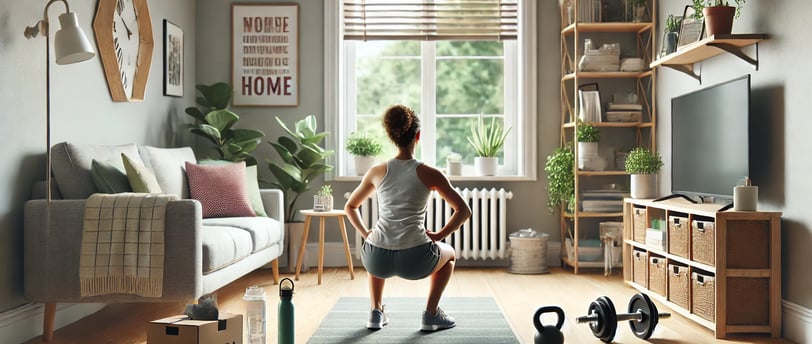Exercising at Home: A Complete Guide for Beginners
12/13/20242 min read


Starting a fitness routine at home is a convenient and cost-effective way to get in shape, especially for beginners. With minimal equipment and the right plan, you can achieve your fitness goals without leaving your living room. In this guide, we’ll walk you through everything you need to start exercising at home.
1. Benefits of Exercising at Home
Exercising at home offers several advantages, including:
Convenience: No commute or waiting for equipment.
Affordability: Save on gym memberships.
Privacy: Work out at your own pace without feeling self-conscious.
Flexibility: Exercise anytime that suits your schedule.
2. Setting Up Your Home Gym
You don’t need a lot of space or fancy equipment to start. Here’s how to set up an effective workout area:
Choose a dedicated space: Clear a small area where you can move freely.
Invest in basic equipment: Start with essentials like a yoga mat, resistance bands, and dumbbells.
Use household items: Water bottles can double as weights, and a sturdy chair can be used for dips or step-ups.
3. Beginner-Friendly Exercises to Try at Home
Focus on exercises that work multiple muscle groups and improve overall fitness. Here are some beginner-friendly moves:
Bodyweight Squats: Strengthen your legs and core.
Push-Ups: Build upper body strength; modify by doing them on your knees if needed.
Planks: Improve core stability and posture.
Lunges: Enhance balance and target your lower body.
Glute Bridges: Strengthen your hips and lower back.
Start with 10–15 repetitions per exercise and aim for 2–3 sets.
4. Cardio Workouts Without Equipment
Cardio is essential for heart health and calorie burning. Try these no-equipment options:
Jumping Jacks: A simple full-body exercise.
High Knees: Get your heart rate up while engaging your core.
Mountain Climbers: Combine cardio with core strength.
Burpees: A full-body workout that boosts endurance.
Perform each exercise for 30 seconds and rest for 15 seconds before repeating.
5. Structuring Your Home Workouts
Consistency is key to seeing results. Here’s a simple weekly plan:
Day 1: Full-body strength training.
Day 2: Cardio or active recovery like walking.
Day 3: Rest or yoga.
Day 4: Upper body and core focus.
Day 5: Cardio.
Day 6: Lower body strength training.
Day 7: Rest or light stretching.
Gradually increase intensity as you build strength and stamina.
6. Staying Motivated at Home
It’s easy to skip workouts when you’re at home, but these tips can help:
Set specific goals: Write down what you want to achieve.
Create a routine: Pick a consistent time to exercise.
Use music or videos: Follow online classes or playlists to keep things fun.
Track progress: Celebrate milestones to stay motivated.
7. Tips for Avoiding Injury
Safety should always come first. Follow these guidelines to prevent injuries:
Warm up: Spend 5–10 minutes doing light cardio and dynamic stretches.
Use proper form: Watch tutorials or consult trainers to ensure correct technique.
Listen to your body: Stop if you feel pain or discomfort.
Cool down: Stretch after every workout to aid recovery.
8. Online Resources for Home Workouts
The internet offers countless resources to guide your workouts. Here are some great options:
YouTube Channels: Follow beginner-friendly fitness channels like Fitness Blender or Yoga with Adriene.
Fitness Apps: Apps like Nike Training Club or MyFitnessPal provide structured plans.
Social Media: Find inspiration from fitness influencers who share free routines.
Conclusion: Your Home, Your Gym
Exercising at home is an excellent way to take control of your fitness journey. With minimal equipment, a dedicated plan, and consistent effort, you can build strength, improve endurance, and achieve your health goals—all from the comfort of your own space.
